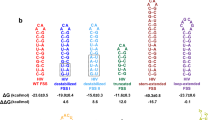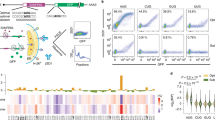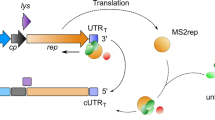Abstract
Interferon-γ mRNA activates the RNA-dependent protein kinase PKR, which in turn strongly attenuates translation of interferon-γ mRNA. Unlike riboswitches restricted to noncoding regions, the interferon-γ RNA domain that activates PKR comprises the 5′ UTR and 26 translated codons. Extensive interferon-γ coding sequence is thus dedicated to activating PKR and blocking interferon-γ synthesis. This implies that the PKR activator is disrupted by ribosomes during translation initiation and must refold promptly to restore PKR activation. The activator structure harbors an essential kink-turn, probably to allow formation of a pseudoknot that is critical for PKR activation. Three indispensable short helices, bordered by orientation-sensitive base pairs, align with the pseudoknot stem, generating RNA helix of sufficient length to activate PKR. Through gain-of-function mutations, we show that the RNA activator can adopt alternative conformations that activate PKR. This flexibility promotes efficient refolding of interferon-γ mRNA, which is necessary for its dual function as translation template and activator of PKR, and which thus prevents overexpression of this inflammatory cytokine.
This is a preview of subscription content, access via your institution
Access options
Subscribe to this journal
Receive 12 print issues and online access
$259.00 per year
only $21.58 per issue
Buy this article
- Purchase on Springer Link
- Instant access to full article PDF
Prices may be subject to local taxes which are calculated during checkout






Similar content being viewed by others
References
Stark, G.R., Kerr, I.M., Williams, B.R., Silverman, R.H. & Schreiber, R.D. How cells respond to interferons. Annu. Rev. Biochem. 67, 227–264 (1998).
Dever, T.E., Dar, A.C. & Sicheri, F. The eIF2α kinases. in Translational Control in Biology and Medicine (eds. Mathews, M.B., Sonenberg, N. & Hershey, J.W.) 319–344 (Cold Spring Harbor Laboratory Press, Cold Spring Harbor, New York, USA, 2007).
García, M.A. et al. Impact of protein kinase PKR in cell biology: from antiviral to antiproliferative action. Microbiol. Mol. Biol. Rev. 70, 1032–1060 (2006).
Sadler, A.J. & Williams, B.R. Interferon-inducible antiviral effectors. Nat. Rev. Immunol. 8, 559–568 (2008).
Osman, F., Jarrous, N., Ben-Asouli, Y. & Kaempfer, R. A cis-acting element in the 3′-untranslated region of human TNF-α mRNA renders splicing dependent on the activation of protein kinase PKR. Genes Dev. 13, 3280–3293 (1999).
Ben-Asouli, Y., Banai, Y., Pel-Or, Y., Shir, A. & Kaempfer, R. Human interferon-gamma mRNA autoregulates its translation through a pseudoknot that activates the interferon-inducible protein kinase PKR. Cell 108, 221–232 (2002).
Kaempfer, R. RNA sensors: novel regulators of gene expression. EMBO Rep. 4, 1043–1047 (2003).
Billiau, A. Interferon-gamma: biology and role in pathogenesis. Adv. Immunol. 62, 61–130 (1996).
Gerez, L. et al. Hyperinducible expression of the interferon-gamma (IFN-gamma) gene and its suppression in systemic lupus erythematosus (SLE). Clin. Exp. Immunol. 109, 296–303 (1997).
Arad, G., Levy, R., Hillman, D. & Kaempfer, R. Superantigen antagonist protects against lethal shock and defines a new domain for T-cell activation. Nat. Med. 6, 414–421 (2000).
Bevilacqua, P.C. & Cech, T.R. Minor-groove recognition of double-stranded RNA by the double-stranded RNA-binding domain from the RNA-activated protein kinase PKR. Biochemistry 35, 9983–9994 (1996).
Manche, L., Green, S.R., Schmedt, C. & Mathews, M.B. Interactions between double-stranded RNA regulators and the protein kinase DAI. Mol. Cell. Biol. 12, 5238–5248 (1992).
Zheng, X. & Bevilacqua, P.C. Activation of the protein kinase PKR by short double-stranded RNAs with single-stranded tails. RNA 10, 1934–1945 (2004).
Winkler, W.C., Cohen-Chalamish, S. & Breaker, R.R. An mRNA structure that controls gene expression by binding FMN. Proc. Natl. Acad. Sci. USA 99, 15908–15913 (2002).
Winkler, W.C. & Breaker, R.R. Genetic control by metabolite-binding riboswitches. ChemBioChem. 4, 1024–1032 (2003).
Mandal, M. & Breaker, R.R. Gene regulation by riboswitches. Nat. Rev. Mol. Cell Biol. 5, 451–463 (2004).
Batey, R.T., Gilbert, S.D. & Montange, R.K. Structure of a natural guanine-responsive riboswitch complexed with the metabolite hypoxanthine. Nature 432, 411–415 (2004).
Thore, S., Leibundgut, M. & Ban, N. Structure of the eukaryotic thiamine pyrophosphate riboswitch with its regulatory ligand. Science 312, 1208–1211 (2006).
Cheah, M.T., Wachter, A., Sudarsan, N. & Breaker, R.R. Control of alternative RNA splicing and gene expression by eukaryotic riboswitches. Nature 447, 497–500 (2007).
Soukup, G.A. & Breaker, R.R. Relationship between internucleotide linkage geometry and the stability of RNA. RNA 5, 1308–1325 (1999).
Klein, D.J., Schmeing, T.M., Moore, P.B. & Steitz, T.A. The kink-turn: a new RNA secondary structure motif. EMBO J. 20, 4214–4221 (2001).
Nallagatla, S.R. et al. 5′-triphosphate-dependent activation of PKR by RNAs with short stem-loops. Science 318, 1455–1458 (2007).
Lescoute, A., Leontis, N.B., Massire, C. & Westhof, E. Recurrent structural RNA motifs, isostericity matrices and sequence alignments. Nucleic Acids Res. 33, 2395–2409 (2005).
Lescoute, A. & Westhof, E. The interaction networks of structured RNAs. Nucleic Acids Res. 34, 6587–6604 (2006).
Lescoute, A. & Westhof, E. Topology of three-way junctions in folded RNAs. RNA 12, 83–93 (2006).
Jaeger, L., Verzemnieks, E.J. & Geary, C. The UA_handle: a versatile submotif in stable RNA architectures. Nucleic Acids Res. 37, 215–230 (2009).
Strobel, S.A., Adams, P.L., Stahley, M.R. & Wang, J. RNA kink turns to the left and to the right. RNA 10, 1852–1854 (2004).
Reyes, A., Gissi, C., Pesole, G., Catzeflis, F.M. & Saccone, C. Where do rodents fit? Evidence from the complete mitochondrial genome of Sciurus vulgaris. Mol. Biol. Evol. 17, 979–983 (2000).
Murphy, W.J. et al. Molecular phylogenetics and the origins of placental mammals. Nature 409, 614–618 (2001).
Vandenbroeck, K., Dijkmans, R., van Aerschot, A. & Billiau, A. Engineering by PCR-based exon amplification of the genomic porcine interferon-gamma DNA for expression in Escherichia coli. Biochem. Biophys. Res. Commun. 180, 1408–1415 (1991).
Circle, D.A., Neel, O.D., Robertson, H.D., Clarke, P.A. & Mathews, M.B. Surprising specificity of PKR binding to delta agent genomic RNA. RNA 3, 438–448 (1997).
Guerrier-Takada, C., Eder, P.S., Gopalan, V. & Altman, S. Purification and characterization of Rpp25, an RNA-binding protein subunit of human ribonuclease P. RNA 8, 290–295 (2002).
Suess, B., Fink, B., Berens, C., Stentz, R. & Hillen, W. A theophylline responsive riboswitch based on helix slipping controls gene expression in vivo. Nucleic Acids Res. 5, 1610–1614 (2004).
Acknowledgements
We thank E. Westhof for valuable suggestions and V. Bafna for bioinformatic analysis of the rodent IFN-γ genes. We thank A. Billiau (Catholic University of Leuven) for porcine IFN-γ cDNA. This work was supported by grants from the Israel Science Foundation and the German Research Foundation (DFG).
Author information
Authors and Affiliations
Contributions
S.C.-C. performed in-line structure probing and cloned mouse IFN-γ DNA; S.C.-C., A.H., D.W. and F.O. generated mutant RNA transcripts; L.S.N. and F.O. expressed recombinant PKR; R.K. and Y.B. prepared rabbit reticulocyte ribosomes; A.H., Y.B., D.W. and S.C.-C. assayed PKR activation; A.H. and Y.B. measured translation efficiency in cells; R.K. and S.C.-C. designed the study.
Corresponding author
Supplementary information
Supplementary Text and Figures
Supplementary Figures 1–7 (PDF 1527 kb)
Rights and permissions
About this article
Cite this article
Cohen-Chalamish, S., Hasson, A., Weinberg, D. et al. Dynamic refolding of IFN-γ mRNA enables it to function as PKR activator and translation template. Nat Chem Biol 5, 896–903 (2009). https://doi.org/10.1038/nchembio.234
Received:
Accepted:
Published:
Issue Date:
DOI: https://doi.org/10.1038/nchembio.234
This article is cited by
-
HIV co-opts a cellular antiviral mechanism, activation of stress kinase PKR by its RNA, to enable splicing of rev/tat mRNA
Cell & Bioscience (2023)
-
Mucosal immunity and tRNA, tRF, and tiRNA
Journal of Molecular Medicine (2021)
-
Intragenic regulation of SOCS3 isoforms
Cell Communication and Signaling (2019)
-
Crystal structure of an adenovirus virus-associated RNA
Nature Communications (2019)
-
Functional 5′ UTR mRNA structures in eukaryotic translation regulation and how to find them
Nature Reviews Molecular Cell Biology (2018)



